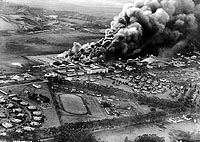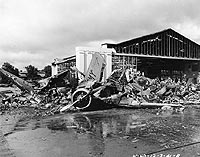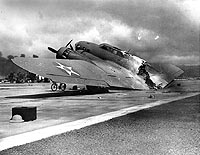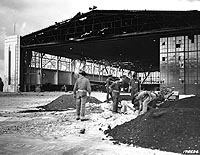
Military and Naval aircraft at Oahu's airfields were second only to battleships among the Japanese target priorities, though the reason was different. While Pearl Harbor's battleships represented American strategic "reach", and had to be eliminated to safeguard Japan's offensive into Southeast Asia and the East Indies, Oahu's aircraft had to be taken out for a more immediate reason: to protect the Pearl Harbor attack force. U.S. fighter planes, if they could get into the air in any numbers, would be a serious threat to Japanese bombers. U.S. Army bombers and Navy patrol planes potentially imperiled the Striking Force's invaluable aircraft carriers.
The Japanese first attack wave therefore assigned many fighters and bombers to airbase supression, the fighters to set planes afire with machine gun and cannon fire and the bombers to wreck them with high explosives. The second attack wave also had airfield strikes among its tasks. Wheeler Army Airfield, in central Oahu, was Hawaii's main fighter base. It was heavily attacked. Of some 140 planes on the ground there, mainly P-40 and P-36 pursuits, nearly two-thirds were destroyed or put out of action. A similar proportion of the B-17, B-18 and A-20 bombers at Hickam Army Airfield, adjacent to the Pearl Harbor Navy Yard, was also wrecked or damaged enough to keep them grounded. Many men were killed at Hickam when the Japanese bombed their barracks. Smaller Bellows Field in eastern Oahu was also hit, destroying several P-40s, including two whose pilots courageously attempted to take off in the teeth of the enemy onslaught.
U.S. Navy and Marine Corps air stations on Pearl Harbor's Ford Island, at Ewa to the west of Pearl and at Kanoehe Bay near Bellows Field, also received concentrated attention from the raiders. Ewa's aircraft complement, mainly carrier-type bombers and fighters, was reduced from nearly fifty operational planes to less than twenty. Ford Island and Kanoehe, home to several squadrons of long-range PBY patrol seaplanes, were massively attacked, with Ford Island losing about half its planes and Kaneohe all but a few.
These very successful Japanese strikes thus prevented any significant aerial opposition, though the few Army fighters that got airborne gave a good account of themselves. Later on December Seventh, surviving bombers and patrol planes were sent out to search for the Japanese carriers. They found nothing and confronted considerable "friendly" anti-aircraft gunfire when they returned to their bases.
This page features views of Japanese air attacks on Army airfields during the Pearl Harbor Raid, and provides links to pictures of strikes on other airfields and of combat in the air.
For other views related to Japanese attacks on airfields
and of aerial combat during the Pearl Harbor raid, see:
For additional pictorial coverage of the Japanese attack
on Pearl Harbor, see:
| If you want higher resolution reproductions than the Online Library's digital images, see: "How to Obtain Photographic Reproductions." |
Click on the small photograph to prompt a larger view of the same image.
|
Photo #: NH 50473 Pearl Harbor Attack, 7 December 1941 Planes and hangars burning at Wheeler Army Air Field, Oahu, soon after it was attacked in the morning of 7 December 1941, as seen from a Japanese Navy plane. Donation of Theodore Hutton, 1942. U.S. Naval History and Heritage Command Photograph. Online Image: 117KB; 740 x 550 pixels |
 |
|
Photo #: 80-G-21217 Pearl Harbor Raid, 7 December 1941 Wheeler Air Field and Schofield Barracks under attack, as seen from a Japanese Navy plane. Most of the smoke comes from planes burning on the Wheeler Field apron in the center. Official U.S. Navy Photograph, now in the collections of the National Archives. Online Image: 86KB; 740 x 610 pixels Reproductions of this image may also be available through the National Archives photographic reproduction system. |
 |
|
Photo #: 80-G-32896 Pearl Harbor Attack, 7 December 1941 U.S. Army aircraft destroyed by Japanese raiders at Wheeler Air Field. Photographed later in the day on 7 December 1941, following the end of the attacks. Wreckage includes at least one P-40 and a twin-engine amphibian. Note the wrecked hangar in the background. Official U.S. Navy Photograph, now in the collections of the National Archives. Online Image: 128KB; 740 x 605 pixels Reproductions of this image may also be available through the National Archives photographic reproduction system. |
 |
|
Photo #: 80-G-32906 Pearl Harbor Attack, 7 December 1941 Men examine the burned-out wreckage of a P-40 pursuit aircraft, near Hangar 4 at Wheeler Air Field, following the end of the Japanese raid on 7 December 1941. Note long blast tubes for the plane's nose machine guns. Official U.S. Navy Photograph, now in the collections of the National Archives. Online Image: 130KB; 740 x 605 pixels Reproductions of this image may also be available through the National Archives photographic reproduction system. |
 |
|
Photo #: SC 134872 Pearl Harbor Attack, 7 December 1941 Destroyed U.S. Army aircraft at Wheeler Field, Oahu, during post-attack cleanup activities. P-40 pursuit planes are among the types present. Photograph from the Army Signal Corps Collection in the U.S. National Archives. Online Image: 101KB; 740 x 600 pixels Reproductions of this image may also be available through the National Archives photographic reproduction system. |
 |
|
Photo #: 80-G-21218 Pearl Harbor Raid, 7 December 1941 Japanese Navy Type 97 Carrier Attack Plane ("Kate") flies high over Hickam Army Air Field during the attack. Pearl Harbor is in the background, with smoke rising from burning ships off Ford Island and at the Navy Yard. Photographed from a Japanese plane. Official U.S. Navy Photograph, now in the collections of the National Archives. Online Image: 105KB; 740 x 610 pixels Reproductions of this image may also be available through the National Archives photographic reproduction system. |
 |
|
Photo #: NH 50931 Pearl Harbor Attack, 7 December 1941 Torpedo planes attack "Battleship Row" at about 0800 on 7 December, seen from a Japanese aircraft. Ships are, from lower left to right: Nevada (BB-36) with flag raised at stern; Arizona (BB-39) with Vestal (AR-4) outboard; Tennessee (BB-43) with West Virginia (BB-48) outboard; Maryland (BB-46) with Oklahoma (BB-37) outboard; Neosho (AO-23) and California (BB-44). West Virginia, Oklahoma and California have been torpedoed, as marked by ripples and spreading oil, and the first two are listing to port. Torpedo drop splashes and running tracks are visible at left and center. White smoke in the distance is from Hickam Field. Grey smoke in the center middle distance is from the torpedoed USS Helena (CL-50), at the Navy Yard's 1010 dock. Japanese writing in lower right states that the image was reproduced by authorization of the Navy Ministry. U.S. Naval History and Heritage Command Photograph. Online Image: 144KB; 740 x 545 pixels |
 |
|
Photo #: SC 127002 Pearl Harbor Attack, 7 December 1941 A U.S. Army B-17E at Hickam Air Field, after landing safely during the Japanese air raid. In the background is a B-17C (or B-17D). Smoke from burning ships at Pearl Harbor is visible in the distance. The B-17E is probably that piloted by First Lieutenant Karl T. Barthelmess. Photographer may be Staff Sergeant Lee Embree. Photograph from the Army Signal Corps Collection in the U.S. National Archives. Online Image: 103KB; 740 x 605 pixels Reproductions of this image may also be available through the National Archives photographic reproduction system. |
 |
|
Photo #: 80-G-32915 Pearl Harbor Attack, 7 December 1941 Wrecked Army Air Corps B-17C (serial # 40-2074) bomber near Hangar # 5 at Hickam Air Field, following the end of the Japanese raid. This plane, piloted by Captain Raymond T. Swenson, was one of those that arrived during the raid after flying in from California. It was hit by a strafing attack after landing and burned in half. Note Note bicycle parked by the plane. Pith helmet by the case in the left foreground indicates that the photographer was Tai Sing Loo. Official U.S. Navy Photograph, now in the collections of the National Archives. Online Image: 109KB; 740 x 600 pixels Reproductions of this image may also be available through the National Archives photographic reproduction system. |
 |
|
Photo #: SC 176626 Pearl Harbor Attack, 7 December 1941 Bomb damage to Hangars 15-17 and 11-13 at Hickam Field, Oahu, at 5PM on 7 December 1941. In the right foreground is a machine gun emplacement in a bomb crater. A Douglas B-18 bomber is visible inside the badly damaged hangar. Photograph from the Army Signal Corps Collection in the U.S. National Archives. Online Image: 113KB; 740 x 600 pixels Reproductions of this image may also be available through the National Archives photographic reproduction system. |
 |
|
Photo #: SC 127000 Pearl Harbor Attack, 7 December 1941 Damaged U.S. Army P-40 pursuit plane at Bellows Field, Oahu, on 9 December 1941, two days after the Japanese air raid. This plane is reportedly one that was involved in a collision on the airfield during a misty morning take-off attempt on 8 December 1941. Photograph from the Army Signal Corps Collection in the U.S. National Archives. Online Image: 65KB; 740 x 600 pixels Reproductions of this image may also be available through the National Archives photographic reproduction system. |
 |
For other views related to Japanese attacks on airfields
and of aerial combat during the Pearl Harbor raid, see:
For additional pictorial coverage of the Japanese attack
on Pearl Harbor, see:
NOTES:
| If you want higher resolution reproductions than the Online Library's digital images, see: "How to Obtain Photographic Reproductions." |
Page made 12 November 2000
Coding updated 17 April 2009